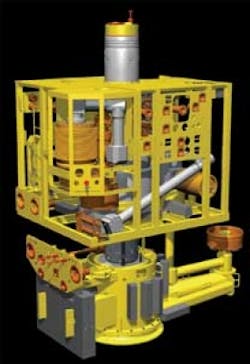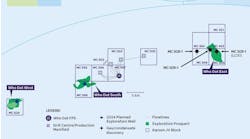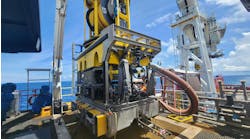Gene Kliewer - Technology Editor, Subsea & Seismic
Production started on July 13 at Shell’s multi-field Parque das Conchas (called BC-10 in its early days) project 110 km (68 mi) off Brazil’s southeast coast. Production is via the FPSOEspírito Santo in the BC-10 field in the Campos basin, according to the BC-10 Joint Venture, which is operated by Shell with ONGC Campos and Petrobras as partners.
Parque das Conchas is a two-phase project with initial production drawn from three fields: Abalone, Ostra, and Argonauta B-West. The first phase involves nine producing wells and one gas injector well. The second phase will focus on the Argonauta O-North field. Shell executed a host of new and advanced technologies to meet the project’s many challenges, among them water depth and oil viscosity.
Electric pumps with 1,500 hp drive the oil 1,800 m (5,905 ft) from the seabed to the ocean surface for processing atEspírito Santo. Production is from 900 m to 1,100 m (2,953 ft to 3,609 ft) below the mudline. The FPSO can process 100,000 b/d of oil and 50 MMcf/d of natural gas, and store nearly 1.5 MMbbl of oil for shipment to shore by transport tankers.
“This marks a major milestone in delivering oil from Brazil’s deepwater and demonstrates Shell’s capability of delivering projects on time and on budget in a complex environment,” says Marvin Odum, Shell Upstream Americas director. “We are proud of the many technologies this project advanced, the jobs it created, and the investment it spurred,” he adds. “It’s a testament to strong relationships and shared values -- a true partnership between the people and government of Brazil and Shell.”
Among those technology highlights are the following:
- Parque das Conchas is the first full-field development using subsea oil and gas separation and subsea pumping
- The water depth required weight reduction and the development of buoyant steel risers – flexible steel pipes several kilometers long that anchor the FPSO in place
- The field geology with its scattered formations demanded extended horizontal drilling for better production
- To keep the heavy oil (16-42º API) flowing, the FPSO, with 68 MW of power generation capacity, feeds power to the deepwater separation and high-pressure pumping systems through huge electrical umbilical cables
- To avoid flaring and reduce CO2 emissions, natural gas produced with the oil is separated and pumped back into the Ostra field awaiting a gas export pipeline.
The FPSO is the deepest moored FPSO of SBM’s fleet and the first turret moored FPSO ever to use steel catenary risers for fluid transfer, SBM says. SBM and MISC operate the unit.
The three Parque das Conchas fields are developed with subsea wells and manifolds, with each field tied back to the FPSO. The development is the first of its kind based fully on subsea oil and gas separation and subsea pumping. The drilling program uses floating-rig surface blow-out preventer well drilling and completions. The development includes the first application of steel tube hydraulic and multi-circuit high power umbilicals. It is also the first application of lazy wave steel riser technology on a turreted FPSO.
Shell is drawing from a smaller application pioneered by Petrobras but scaled up to BC-10 volumes to separate the two-phase production flow at the seabed. Petrobras in 2000 worked on a vertical annular separator. The production flow enters the caisson at a tangent to establish a centrifugal force which sends the oil to the outside and leaves the gas in the middle.
“There is an optimization to flowing multiple wells into one caisson,” says Paul Dorgant, Shell venture manager for BC-10. “The caisson is basically a large, tubular ‘false well’ that goes to 100 m (328 ft) down. Production goes into that caisson and the ESP is inside the caisson. Production is commingled and separation occurs within the caisson. Liquids are pumped up the liquid line and gas flows up into the gas line.”
To accommodate the ESPs, there are six 48-in. (122-cm) conductors driven through subsea templates.
FMC Technologies and Shell designed the Enhanced Vertical Deepwater Tree (EVDT) system for versatility, installation savings, and operational efficiency. The EVDT was designed with a slimbore completion system. Outside diameter of the tubing hanger equipment is only 13 2/5 in. (34 cm) so it can pass through a 13 5/8-in. (34.6-cm) BOP stack. The bore of the system can accommodate 7-in. (17.8-cm) tubing completions and handle pressures up to 15,000 psi.
The EVDT allows for deepwater completions from a small drilling rig containing a surface BOP, thus avoiding the need for an expensive deepwater rig and subsea BOP system. Operators can save $5 million to $15 million per well by using the deepwater rig more effectively, focused on drilling operations only, says FMC.
Shell is planning to use the Generation 3 rigArctic 1 with a surface BOP for both drilling and completion at BC-10 offshore Brazil. Otherwise, Shell says, it would require a Generation 5 rig, if one could be found available.
At a glance
- Location: Campos basin, Brazil
- Depth: 1,780 m (5,840 ft)
- Interests: Shell 50% (operator), Petrobras 35%, ONGC 15%
- Fields: Ostra, Abalone, Argonauta
- FPSO design capacity: 100,000 boe/d of 17-42ºAPI
- Key contractors: BDFT (JV between SBM/MISC), Subsea 7, FMC Technologies, V&M do Brasil, Oceaneering, Transocean/Global Santa Fe, Halliburton





